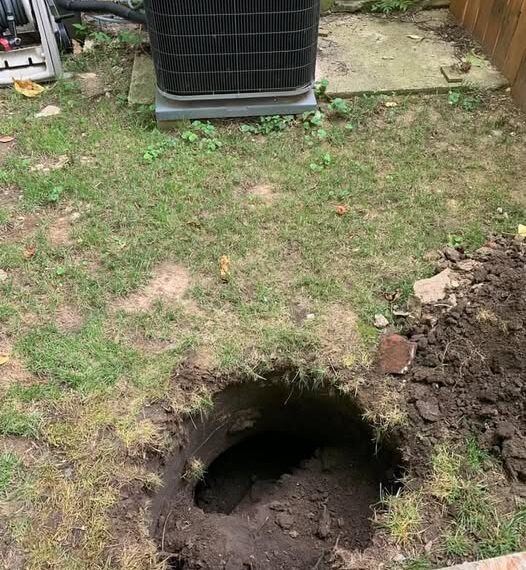Imagine stepping into your backyard after a heavy rainstorm and discovering a mysterious hole in the ground. For homeowners, especially those residing in historic properties dating back to the early 20th century, such subterranean anomalies can be both intriguing and unsettling. These unexpected findings often spark curiosity and speculation about the secrets lying beneath our feet.
1. Cisterns: The Rainwater Reservoirs of the Past
Cisterns were once commonplace in older homes, particularly those built before the advent of modern plumbing systems. These waterproof containers were designed to collect and store rainwater for household use, serving as a vital resource in times when municipal water systems were either unavailable or unreliable. Constructed from materials like brick, stone, or concrete, cisterns were often located underground to maintain a cool temperature and reduce evaporation.
Over time, as indoor plumbing became widespread, many cisterns were abandoned and either filled in or forgotten. However, some have been rediscovered, offering a glimpse into past water conservation practices. For instance, a 19th-century brick cistern was uncovered in Fort Greene, Brooklyn, during a construction project. Archaeologists found artifacts within the cistern, shedding light on the daily lives of its previous occupants .brownstoner.com+1brownstoner.com+1
2. Old Wells: Echoes of a Pre-Plumbing Era
Before the establishment of reliable city water systems, wells were the primary source of water for many households. These wells were typically dug by hand and lined with stone or brick to prevent collapse. Even after they fell out of use, some wells were never properly sealed, leading to potential hazards. In some cases, the surrounding soil erodes over time, causing the ground above to sink and reveal the hidden well beneath.
A Reddit user shared an experience of uncovering an old well in their backyard, describing it as a deep, stone-lined hole that had been concealed by years of overgrowth. Such discoveries are not uncommon, especially in areas with a rich history of early settlement.
3. Cesspits and Septic Tanks: The Waste Disposal Systems of Yesteryear
Before the advent of modern sewer systems, cesspits and rudimentary septic tanks were used to manage household waste. These underground pits were designed to contain waste until it could be safely removed or decomposed. Over time, as sanitation practices improved, many of these systems were abandoned. However, some may still exist beneath older properties, posing potential health risks if disturbed.
In some instances, the collapse of a cesspit or septic tank can create a sudden sinkhole, as the surrounding soil gives way. It’s crucial for homeowners to be aware of the signs of such systems and take precautions when undertaking landscaping or construction projects.
4. Utility Vaults and Storage Cellars: Hidden Chambers Beneath the Home
In certain historic homes, builders incorporated underground vaults or storage cellars into the design. These spaces were used for various purposes, such as storing coal, preserving food, or housing utilities like water tanks. Over time, these areas may have been sealed off or repurposed, but remnants of their existence can sometimes be found during renovations.
For example, a Reddit user recounted discovering a large cistern beneath their basement, which had been partially filled in and converted into a cellar when their small rural town received municipal water. Such findings highlight the adaptive reuse of space in historic homes .reddit.com
5. Natural Sinkholes: Geological Surprises Beneath the Surface
In regions with certain geological characteristics, natural sinkholes can form when underlying rock dissolves, causing the ground above to collapse. These sinkholes can appear suddenly and may be mistaken for the remnants of human-made structures. For instance, in South Dakota’s Hideaway Hills neighborhood, residents experienced giant sinkholes linked to an old mine beneath the community, leading to significant property damage and safety concerns .
While less common, natural sinkholes serve as a reminder of the dynamic processes occurring beneath our feet and the importance of understanding local geology when assessing potential hazards.
Conclusion: Embracing the Mysteries Beneath Our Homes
Discovering hidden features beneath a historic property can be both fascinating and daunting. Whether it’s an old cistern, well, cesspit, utility vault, or natural sinkhole, these underground discoveries offer a tangible connection to the past. They remind us of the evolving ways in which people have interacted with their environment and managed resources.
For homeowners encountering such features, it’s essential to approach the situation with caution. Consulting with professionals, such as archaeologists, historians, or structural engineers, can provide valuable insights and guidance. Additionally, local historical societies or museums may offer resources to help interpret and preserve these discoveries.reddit.com
By understanding and respecting the hidden histories beneath our homes, we can ensure that these remnants of the past are preserved for future generations to appreciate and learn from.





